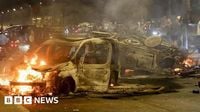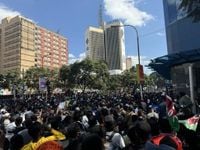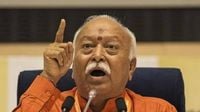In recent weeks, a wave of youth-driven protests has swept across continents, shaking the very foundations of governments in South Asia and Latin America. The epicenter of this global tremor: the streets of Kathmandu and Asunción, where Generation Z—those born between the late 1990s and 2010—have taken a stand against entrenched corruption, nepotism, and political inertia. Their message? Enough is enough.
On September 8, 2025, Kathmandu became a flashpoint for this generational revolt. According to Republica, thousands of young Nepalis, frustrated by corruption and a political system dominated by septuagenarian leaders, organized a mass protest demanding change. The government, led by KP Sharma Oli, responded with force in a chilling echo of Tiananmen Square: security forces fired indiscriminately into the crowd, killing nineteen young protesters. The tragedy only fanned the flames of public anger. By the next morning, Kathmandu had erupted. The city’s streets filled with citizens of all ages, united in solidarity with Gen Z’s call for reform.
But what began as a peaceful demonstration quickly spiraled out of control. On September 9, opportunists and criminal elements infiltrated the crowds. The result was chaos: protestors set fire to key government buildings, including Singha Durbar, the Health Ministry, the Supreme Court, the Parliament Building, and even the Presidential Palace. Police stations, ministerial homes—including those of Prime Minister Oli and former prime ministers Sher Bahadur Deuba and Pushpa Kamal Dahal—were not spared. The unrest spread like wildfire across Nepal, sparking similar scenes in towns nationwide. Within just two days, the government fell—one of the shortest-lived protest movements in political history to topple a sitting administration.
This was not an isolated event. As Peoples Dispatch reported, just days later on September 28, hundreds of Paraguayans—under the banner "We are the 99.9%"—marched through Asunción to protest President Santiago Peña’s right-wing government and a political structure they say is rotten with corruption and nepotism. Protestors decried the rise of narco-politics, the lack of opportunities for youth, and a system where, as journalist Amado Arrieta told Peoples Dispatch, “the children of politicians get the best jobs, sometimes without having the necessary skills.”
Transparency International’s 2024 Corruption Perceptions Index paints a grim picture: Paraguay remains one of Latin America’s most corrupt countries. “Here in Paraguay, we are really asking for security, justice, and health in our country … [We reject] corrupt politicians who steal from the people right in front of them,” nursing student Jenifer González told EFE. The protests in Asunción, like those in Kathmandu, were marked by the prominent participation of Gen Z, but also drew in older generations united by a shared frustration with the status quo.
The government’s response in Paraguay was swift and forceful. An estimated 3,000 police officers were deployed against a crowd of 600 to 700 protesters. More than 30 people were arrested and 10 injured, with the Chamber of Deputies condemning what it termed “police repression.” According to Arrieta, “before the protest, there was a campaign in the mainstream media that sought to instill fear in the population, suggesting that the Paraguayan March [a political crisis in 1999] in which many young people died would be repeated.” After the demonstration, reports emerged of a “witch hunt” in which police detained anyone in the area, often without due process or a prosecutor present.
These scenes are not new in Paraguay. The country has a long history of youth activism, from resistance to Alfredo Stroessner’s dictatorship (1954-1989) to the 1999 Paraguayan March, which left eight dead and more than 700 injured. In 2017, young people set fire to the Parliament building after a controversial bill was passed. While the faces and slogans may change, the underlying grievances—corruption, inequality, abuse of power—remain stubbornly persistent.
Back in Nepal, the roots of the uprising run deep. As Republica noted, nearly one-third of Nepal’s GDP comes from remittances, with many young people forced to take menial jobs abroad due to high unemployment and lack of opportunity at home. Meanwhile, a new class of political elites and their "nepo-babies" flaunt extravagant lifestyles, further fueling resentment. Since Nepal’s proclamation as a federal republic, the same handful of leaders—KP Oli, Pushpa Kamal Dahal, and Sher Bahadur Deuba—have rotated power among themselves, perpetuating a culture of impunity. Even at the grassroots, corruption is rampant, with community-level user groups sharing commissions from small contracts.
The uprising in Nepal drew immediate comparisons to similar movements in Sri Lanka (2022) and Bangladesh, where youth-led protests toppled governments. Yet, as Republica pointed out, Nepal’s was the swiftest: “It may be the shortest demonstration in political history to topple a government within hours of its beginning, underscoring the power of the youth.”
These developments have not gone unnoticed in the region. On October 2, Rashtriya Swayamsevak Sangh chief Mohan Bhagwat, speaking at the annual Vijayadashmi rally in Nagpur, expressed concern over the toppling of governments in neighboring countries. According to PTI, Bhagwat stressed that “society can be transformed only through democratic means,” warning that violent outbursts could be exploited by dominant global powers. He highlighted the disconnect between governments and society, and the lack of able, people-oriented administrators as root causes of discontent. “The forces wanting to create such disturbances in India are active inside as well as outside the country,” Bhagwat cautioned, adding that peace, stability, and prosperity in neighboring nations are of vital importance to India.
Bhagwat’s remarks reflect a broader anxiety about regional stability. He recalled the 2022 terrorist attack in Pahalgam, where 26 Indian tourists were killed, as a reminder of the ever-present need for vigilance and security. “While maintaining a policy and spirit of friendship with everyone, we must remain as vigilant as possible and further develop our security capabilities,” he said, urging comprehensive plans for justice, development, goodwill, empathy, and harmony.
As protests ripple across continents, a pattern emerges: a politically aware youth, frustrated by corruption and unresponsive leadership, increasingly sees the ballot box as insufficient. Analyst Leonardo Berniga told DW that “the mobilization shows that there is a politically aware youth, but one that is not represented in the electoral process.” In both Nepal and Paraguay, the challenge now is whether these movements can translate street power into lasting, democratic change—or whether old political structures will simply reassert themselves once the dust settles.
The world is watching. In the end, the fire that Gen Z has lit—demanding justice, opportunity, and real accountability—may prove impossible to extinguish, even in the face of violence and repression. For now, hope persists that this new generation can chart a different course—and perhaps, finally, break the cycle of corruption and impunity that has plagued their countries for decades.



